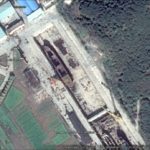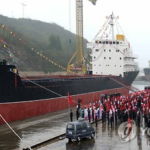Pictured above (Google Earth): The Jaryok (자력) under construction at the Ryongnam Shipyard in Nampho.
Pictured Above (Rodong Sinmun): The Ja-ryok
UPDATE 1 (2017-4-17): According to KCNA:
DPRK Trade Cargo Ship Sets Sail
Nampho, April 17 (KCNA) — The DPRK 5 000-ton trade cargo ship “Jaryok” (self-reliance) set sail.
Respected Supreme Leader Kim Jong Un set forth a task on making a 5 000-ton cargo ship and named it in person.
Workers, technicians and officials of the Ryongnam Dockyard built the “Jaryok” on the occasion of the Day of the Sun and thus provided another material and technical foundation for developing the maritime transport of the country.
Its sailing ceremony took place at the Ryongnam Dockyard on Monday.
Present there were O Su Yong, vice-chairman of the Central Committee of the Workers’ Party of Korea, officials concerned and of the dockyard and others.
Kang Jong Gwan, minister of Land and Maritime Transport, made an inaugural address to be followed by speeches.
The ship left amid the send-off by the participants.
ORIGINAL POST (2016-5-16): According to KCNA:
5,000-ton Trade Cargo Ship 자력 Launched
5,000-ton trade cargo ship “Jaryok” (self-reliance) was built as a present to the Seventh Congress of the Workers’ Party of Korea (WPK).
The ship was launched with due ceremony at the Ryongnam Dockyard on Sunday.
Present at the ceremony were O Su Yong, vice-chairman of the Central Committee of the WPK, officials concerned, officials and employees of the dockyard.
Kang Jong Gwan, minister of Land and Maritime Transport, made an address for the launch to be followed by some speeches.
They said the present success is ascribable to the patriotic devotion of President Kim Il Sung and leader Kim Jong Il to the development of maritime trade and to the leadership of MarshalKim Jong Un and it is also a proof of the loyalty of the working people and officials in the maritime transport field to the party who are determined to bring in earlier the final victory of building a thriving socialist country.
They referred to the fact that Kim Jong Un personally named the cargo ship “Jaryok”.
The loving care and trust of Kim Jong Un is associated with the intention wanting to dynamically promoting the development of the maritime industry in the spirit of self-reliance and self-development, they noted.
They called for attaining the high goal for the development of maritime industry by displaying the revolutionary spirit and mettle of heroic Kim Il Sung-Kim Jong Il working class in close unity around Kim Jong Un and dynamically fighting for the final victory of building a thriving socialist country.
A tape was cut and the cargo ship slid off the launching ways to the sea.


